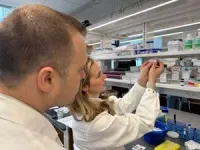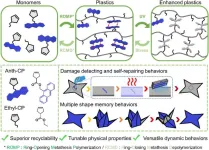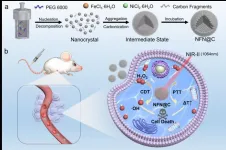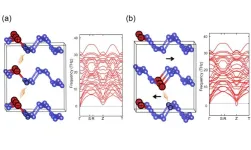Alzheimer’s treatment may lie in the brain’s own cleanup crew
Brain’s immune cells cleared plaques, restored a healthier brain environment in immunized patient brains
2025-03-06
(Press-News.org) MEDIA CONTACT: Kristin Samuelson at 847-769-6596 or ksamuelson@northwestern.edu
EMBARGOED FOR RELEASE: 5 a.m. (ET), Thursday, March 6, 2025
Alzheimer’s treatment may lie in the brain’s own cleanup crew
Brain’s immune cells cleared plaques, restored a healthier brain environment in immunized patient brains
Current FDA-approved Alzheimer’s drugs remain controversial, with modest benefits, high cost
First time cutting-edge technique spatial transcriptomics was used on human clinical-trial brains with Alzheimer’s disease
Findings could reshape the future of Alzheimer’s treatment
CHICAGO --- For more than three decades, scientists have been racing to stop Alzheimer’s disease by removing amyloid beta plaques — sticky clumps of toxic protein that accumulate in the brain. Now, a new Northwestern Medicine study suggests a promising alternative: enhancing the brain’s own immune cells to clear these plaques more effectively.
The findings could reshape the future of Alzheimer’s treatments, shifting the focus from simply removing plaques to harnessing the brain’s natural defenses.
Earlier attempts at an Alzheimer’s vaccine failed when the immune system’s response caused dangerous brain swelling. Even today’s FDA-approved antibody treatments remain controversial, offering only modest benefits with potential side effects and high-price points.
“I think everyone agrees that, although these drugs are becoming more effective, they ultimately do not cure Alzheimer's disease patients,” said corresponding author David Gate, an assistant professor of neurology at Northwestern University Feinberg School of Medicine and the director of the Abrams Research Center on Neurogenomics. “These drugs stimulate the immune cells of the brain to remove amyloid beta, but we believe that the data in our publication can be utilized to make these drugs work even better.”
The paper will be published March 6 in Nature Medicine.
The study is the first to use a cutting-edge technique called spatial transcriptomics on human clinical-trial brains with Alzheimer’s disease. The technique allows scientists to pinpoint the specific spatial location of gene activity inside a tissue sample.
By analyzing donated brain tissue from deceased people with Alzheimer’s disease who received amyloid-beta immunization and comparing it to those who did not, the scientists found that when these treatments work, the brain’s immune cells (called microglia) don’t just clear plaques — they also help restore a healthier brain environment.
But not all microglia are created equal. Some are quite effective at removing plaques, while others struggle, the study found. Also, microglia in treated brains adopt distinct states depending on the brain region and type of immunization. Lastly, certain genes, like TREM2 and APOE, are more active in microglia in response to treatment, helping these cells remove amyloid beta plaques, according to the findings.
“A long-standing question in the field of Alzheimer's therapeutics is if we coax these immune cells into removing the amyloid, are they just always going to be in that amyloid-removal mode?” Gate said. “The answer we found is no, they can remove the amyloid and then go back to being good and appear to actually help the brain heal.”
Stopping Alzheimer’s ‘dominoes’ from falling
The amyloid cascade hypothesis, the prevailing theory of Alzheimer’s disease development, can be compared to a row of dominoes. If amyloid plaques can be cleared from the brain before they trigger the formation of tau pathology — the key driver of cognitive decline in Alzheimer's patients — the cascade is halted before it can begin, preventing further damage.
“The idea is that in people who already have Alzheimer's disease, yes, you can maybe remove amyloid, but if the tau spread has been set in motion, you are fighting an uphill battle,” Gate said. “But maybe, if you treat people so early that they don't yet have tau pathology, you can stop the domino effect from happening. Our study is the first to identify the mechanisms in microglia, the brain’s immune cells, that help limit the spread of amyloid in certain brain regions following treatment with amyloid-targeting drugs.
“If we can define the mechanisms that are associated with clearance of the pathology, and we can find the genetic makeup of immune cells that are associated with people that are really responding well to the drug, then maybe one day we can circumvent the whole drug process and just target these specific cells,” Gate said.
Currently, there isn’t a way to target these immune cells, Gate said, but methods of targeting cells in the brain are improving year over year.
How the study was conducted
The study included six control brains that had no neurologic disease; six brains with Alzheimer’s disease that had not been treated with any immunization drug; and 13 brains that had been vaccinated with amyloid beta. Of those 13, seven had high levels of amyloid-plaque clearance in the brain while the other six had limited amounts of clearance.
The scientists then compared the immune cells in the brains between those two groups.
"Our study is highly novel because we had the rare opportunity to analyze one of the largest post-mortem brain cohorts of Alzheimer's patients treated with amyloid-targeting drugs — similar to those now approved by the FDA for Alzheimer's disease," said lead author Lynn van Olst.
"This allowed us to investigate the brain mechanisms that determine why some individuals respond well to these treatments and successfully clear toxic amyloid-beta, while others do not. We found that brain immune cells play a crucial role in this process and identified the molecular genetic factors that drive these differences."
Funding for the study was provided by the National Institutes of Health National Institutes of Aging R01 grant AG078713, BrightFocus Foundation A2023003S, Alzheimer’s Association 23AARG-1026607,
Alzheimer Nederland Impulssubsidie grant WE.06-2023-03 and Alzheimer Nederland Early Career grant WE.03-2023-08.
END
ELSE PRESS RELEASES FROM THIS DATE:
2025-03-06
Climate change is rapidly reducing the ability of banana producers to supply one of our favourite fruits.
New research from the University of Exeter, published in Nature Food, has found it will be economically unsustainable by 2080 for many areas across Latin America and the Caribbean to continue growing bananas for export, because of rising temperatures caused by climate change.
Bananas are a key export crop worth $11 billion (£8.9 billion) annually and are crucial for the economies of many countries. Yet in just over half a century, 60 per cent of the regions currently producing bananas will ...
2025-03-06
Curtin University researchers have discovered the world’s oldest known meteorite impact crater, which could significantly redefine our understanding of the origins of life and how our planet was shaped.
The team from Curtin’s School of Earth and Planetary Sciences investigated rock layers in the North Pole Dome — an area of the Pilbara region of Western Australia — and found evidence of a major meteorite impact 3.5 billion years ago.
Study co-lead Professor Tim Johnson, from Curtin University, said the discovery significantly ...
2025-03-06
A voluntary pledge made by UK shooting organisations in 2020 to replace lead shot with non-toxic alternatives by 2025 has failed, analysis by Cambridge researchers finds.
The pledge, made in February 2020 by the UK’s nine leading game shooting and rural organisations, aimed to benefit wildlife and the environment and ensure a market for the healthiest game meat food products.
But a Cambridge team, working with the University of the Highlands and Islands, has consistently shown that lead shot was not being phased out quickly enough to achieve ...
2025-03-06
A study led by Dr. Rodrigo Quian Quiroga, group leader of the Neural Mechanisms of Perception and Memory Research Group at the Hospital del Mar Research Institute, has allowed scientists to observe for the first time how neurons in the human brain store memories independent of context in which they are acquired. Published in Cell Reports, the study confirms that neurons can distinguish objects or people regardless of their context, enabling the formation of higher and more abstract relationships, ...
2025-03-06
A new paper in the Journal of Breast Imaging, published by Oxford University Press, indicates that breast cancer mortality rates have stopped declining in women older than age 74, and reconfirms that breast cancer mortality rates have stopped falling in women younger than age 40. This finding for older women is new.
Breast cancer is the second leading cause of cancer deaths in American women, with over 42,000 women dying of the disease in 2024. Before 1990, female breast cancer rates had been rising, and breast cancer mortality rates had been flat or increasing. Since 1990 there has been a steady decline ...
2025-03-06
Plastics, which are polymeric materials composed of long chains of small molecules called monomers, are widely used in everyday life and industry due to their lightweight, good strength and flexibility. However, with approximately 52 million tons of plastic waste generated annually, plastic pollution has become a major environmental concern. To address this issue, research efforts have focused on developing sustainable polymeric materials. Unfortunately, most materials developed so far suffer from complex synthesis processes or difficulties in separating them from other polymers during waste disposal.
To overcome these limitations, a research team led by Dr. Tae Ann Kim of the Convergence ...
2025-03-06
A type of Artificial Intelligence that mimics the functioning of the human brain could represent a powerful solution in automatically detecting wildfires, plummeting the time needed to mitigate their devastating effects, a new study finds.
The new technology uses an ‘Artificial Neural Networks’ model that combines satellite imaging technology with deep learning (a subset of Artificial Intelligence (AI) and machine learning).
Findings, published in the peer-reviewed International Journal of Remote Sensing, report a 93% success rate when training the model via a dataset ...
2025-03-06
Recently, a collaborative research team led by Professor WANG Hui and Professor ZHANG Xin from the Hefei Institutes of Physical Science of the Chinese Academy of Sciences, successfully developed a novel carbon-coated nickel ferrite (NFN@C) nanocatalyst with significant potential in cancer therapy.
The results have been published in Advanced Functional Materials.
Cancer therapy has always struggled with targeting tumor cells effectively while minimizing damage to healthy tissue. Traditional treatments like chemotherapy and radiation often have limited precision and serious side effects. This has led to increased ...
2025-03-06
New research by Curtin University has achieved a breakthrough in eco-friendly display technology, creating highly efficient and stable blue quantum dot LEDs (QLEDs) that could power the next generation of televisions, smartphones, VR headsets and energy-efficient lighting - without using toxic heavy metals.
Study author Associate Professor Guohua Jia from Curtin’s School of Molecular and Life Sciences said QLEDs are a futuristic display technology known for their superior brightness, colour accuracy, lifetime and energy efficiency compared to traditional LEDs. However, creating stable and efficient blue QLEDs without toxic materials ...
2025-03-06
Using first-principles calculations, a research group led by Prof. WANG Xianlong from the Hefei Institutes of Physical Science of the Chinese Academy of Sciences, found that phosphorus doping is an effective way to achieve high-energy polymeric nitrogen with black-phosphorus structure (BP-N) stable at ambient pressure.
The research results were published in Matter and Radiation at Extremes.
Cubic gauche nitrogen with diamond-like structure and BP-N with black phosphorus structure, represented by polymeric all-nitrogen materials, are a class of high-energy density materials composed entirely of N-N single bonds, but their samples ...
LAST 30 PRESS RELEASES:
[Press-News.org] Alzheimer’s treatment may lie in the brain’s own cleanup crew
Brain’s immune cells cleared plaques, restored a healthier brain environment in immunized patient brains






